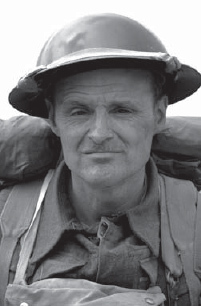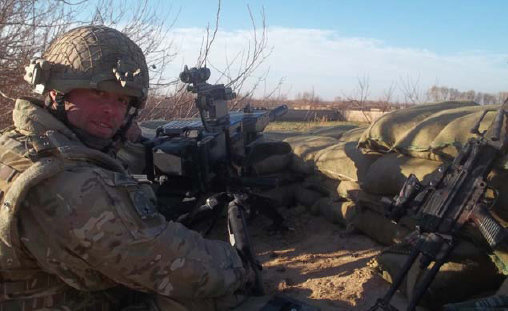Likewise, when you come across a car parked suspiciously as if it might be a bomb waiting to go off at an intersection or significant building, do not approach it yourself. This is what bomb disposal guys are paid for. Keep away and let the bloody thing blow up. You are worth more than a car and a few windows. Of course, this strategy has caused me to be the butt of many jokes and take some criticism but, you will observe, I am still here, typing with both hands and I went for a cycle ride this morning.
ARMOUR FOR SOLDIERS
Combat injuries almost all come from being hit by pieces of metal flying though the air: bullets of various kinds, shrapnel from grenades and mortars, splinters from heavy cannon shells, bombs and mines. What it amounts to is that either a bullet of some kind has been blown down a tube at you or a piece of metal surrounding some explosive has been turned into a cloud of projectiles and driven in your direction by the blast.

A World War II-era British infantry soldier’s helmet. (i-Stock)
Occasionally the projectile is glass from a window or gravel from the ground but the effect is always the same: your skin is punctured so you bleed, the projectile enters your body and damages a vital organ or bits are torn off you. Either way you are damaged and potentially killed.
Human skin is pretty tender stuff so if you can’t entirely avoid being shot at or blown up you will need some protection. A sort of thicker skin. The trouble is that protection is both heavy and restrictive to your movement so it might be an idea to protect just the most critical areas of your body – the areas where, if that bit is damaged, you are likely to die. Pretty obviously, your body, or more specifically your torso, is more essential than your arms and legs as it houses all your vital organs without which you would curl your toes up in short order. More vital even than your body is your head where even a single splinter or heavy tap can leave you unconscious or dead.
Infantry helmets
The solution to protecting your head has been around forever: a helmet of some kind. But what kind? In the modern era helmets were first issued to infantry in time for World War I. Artillery exploding as air burst over the troops’ heads was one of the biggest killers followed by a rifle shot to the head with a high velocity, heavy bullet at long range when anyone looked over the top of their trench.

Tom models the latest British Army GS Mk7 Combat Helmet behind the GMG. This helmet is light, has good mountings for sights and the rear does not catch on armour and push the front down over your eyes. (Photo courtesy Tom Blakey)
It was soon discovered that no helmet light enough to wear could actually stop a bullet as a World War I rifle bullet would go through both sides of a steel helmet at 1,000 yards. The best compromise was to design helmets with broad brims so that most shrapnel coming from above would be stopped from damaging the head and periscopes were devised to look over the tops of trenches. This solution continued through World War II and after until wars became counter-insurgency operations. The significance of this is that a guerrilla army tends not to have effective artillery and therefore the counter-insurgency troops would be wearing a heavy helmet for nothing.
Very many troops have operated against insurgents in the Middle East and elsewhere without helmets right up to Northern Ireland and the present day. As society has softened its attitude to rioters and troops have become expected to tolerate a shower of bricks, rather than putting them down with fire, the helmet has appeared again in a form similar to an open face motorcycle helmet and made of fibre glass so as to protect the soldier from sticks, stones and other hand-thrown missiles. Today this type of helmet is still deployed around the world when troops have to contend with rioters but are not allowed to shoot them.
On the modern battlefield, which is primarily counter-insurgency remember, artillery remains a limited threat to our side but the enemy have the opportunity to use both hand-thrown missiles and rifles. Fortunately, technology has advanced to such a degree that the latest helmets, of the motorcycle style, are now able to defend to some extent against small-arms fire. Certainly a glancing blow from a Kalashnikov rifle at extended range will not penetrate the latest designs. That is quite reassuring is it not?
Infantry body armour
From soon after Napoleonic times to well after World War II no body armour of any significance was worn by the military except for aircrew – to protect them from shrapnel produced by anti-aircraft shells bursting around their plane – and tank crews – to protect them from the shrapnel that scabs off the inside of an armoured fighting vehicle when it is struck hard from the outside.
You will notice that both these forms of armour were for protection from shrapnel. It has usually been shrapnel that killed most servicemen and in any event, rifles were so powerful that armour heavy enough to stop their bullets was not an option. Then in the 1960s the flak jacket started to make an appearance in general issue to troops. A sort of thick waistcoat of some sort of plastic fibre which was light but would stop most shrapnel and pistol or sub-machine gun bullets.
Studies had convinced the ‘top brass’ that by far the greatest number of casualties to all servicemen in World War II were caused not by bullets but by shrapnel so as per usual, the generals were equipping their men to fight the previous war. Some would argue that as shrapnel and low velocity rounds were not a real problem in recent conflicts the main effect of the flak jacket was to improve morale.
Flak jackets have continued to be issued to Western troops since the 1960s for use in riot and counter-insurgency operations. Over the years they have improved in design to become significantly more effective in stopping nasties as well as lighter and easier to work in.
Infantry armour for the present day
Today the question is still where do you draw the line in the balance between weight and protection? One limit to the effectiveness of an infantry soldier is how much supplies, ammunition and explosive he can carry on a patrol. Already British soldiers are carrying up to 150lb of equipment under the Afghan sun so how much armour can they carry when every added pound of armour is a pound less ammunition or stores?
First of all we will look at the main threats:
Artillery is not used against us as air burst in counter-insurgency warfare but there is shrapnel from bombs, mines and rocket propelled anti-tank grenades. Kevlar helmets and standard body armour will stop all this to the head and torso. Fine so far.
But what about rifle fire? The main small arms threat comes from the Kalashnikov rifle firing a 7.62mm x 39mm round and the PKM type machine gun firing a 7.62mm x 54mm round. The machine gun round is much more powerful because it fires the same bullet driven with more propellant and therefore travelling a lot faster.
There is still no wearable helmet which will stop a rifle bullet head-on at close range. Though the latest helmets do deflect a glancing blow – which is comforting. The latest body armour, however, can stop rifle fire to the chest. How does it do that? The Americans have developed a suit of armour for infantry called ‘Interceptor Body Armor’. The British have something similar called the ‘Osprey Mark 4 Body Armour’. I find it strangely comforting that they are both very similar in theory and operation. That suggests to me that different, smart people approaching the same problem in their respective ways came to the same conclusions and therefore these may be right.